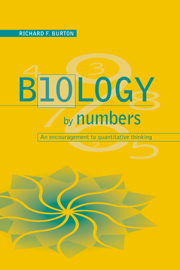Book contents
- Frontmatter
- Contents
- Preface
- A guide to the book
- 1 Putting two and two together
- 2 Units, formulae and the use of old envelopes: confronting some obstacles to quantitative thinking
- 3 Aspects of energy metabolism
- 4 Getting things in proportion
- 5 Perilous percentages, dangerous ratios
- 6 Building a trophic pyramid
- 7 Sodium in animals and plants
- 8 Exchanges of water and carbon dioxide
- 9 A geometric series
- 10 Introduction to logarithms
- 11 Bringing logarithms to life
- 12 Exponential relationships
- 13 Aspects of allometry
- 14 More on allometry, and on quantitative patterns in nature
- 15 How the abundance of food affects rates of feeding
- 16 The characterization of trees and other branching systems
- 17 Epilogue
- References
- Notes
- Index
2 - Units, formulae and the use of old envelopes: confronting some obstacles to quantitative thinking
Published online by Cambridge University Press: 05 June 2012
- Frontmatter
- Contents
- Preface
- A guide to the book
- 1 Putting two and two together
- 2 Units, formulae and the use of old envelopes: confronting some obstacles to quantitative thinking
- 3 Aspects of energy metabolism
- 4 Getting things in proportion
- 5 Perilous percentages, dangerous ratios
- 6 Building a trophic pyramid
- 7 Sodium in animals and plants
- 8 Exchanges of water and carbon dioxide
- 9 A geometric series
- 10 Introduction to logarithms
- 11 Bringing logarithms to life
- 12 Exponential relationships
- 13 Aspects of allometry
- 14 More on allometry, and on quantitative patterns in nature
- 15 How the abundance of food affects rates of feeding
- 16 The characterization of trees and other branching systems
- 17 Epilogue
- References
- Notes
- Index
Summary
Let us pause in our ‘arithmetical progression’ to consider some of the obstacles to quantitative thinking in biology. I have in mind especially such thoughts as may arise out of casual interest rather than from necessity, since the first are too easily put aside in the face of difficulty. The actual arithmetic is easy nowadays with the ubiquitous pocket calculator, but I say something below about back-of-envelope calculations. Beyond that, some of the most tiresome obstacles, in my experience, are those associated with the variety of units that may be met in pursuing a subject through different books and articles – acres versus hectares and square metres, moles versus grams, and so on. As well as commenting on some actual units, I deal also in this chapter with the importance of considering unit consistency in the use of formulae and equations. I discuss that, and the related approach of ‘dimensional analysis’, for their helpfulness in making sense of physical and biological formulae. Quantitative thinking is obviously helped if one has a feel for relevant magnitudes; whether it is useful to remember the mass of an ostrich or the energy content of a seed is a personal matter, but I offer some general guidance. Finally I return to the subject of making sense of equations and formulae, mindful of the difficulties many people have with them. My examples are chosen to illustrate general points and I do not assume that all readers either know all of them already, or need them.
- Type
- Chapter
- Information
- Biology by NumbersAn Encouragement to Quantitative Thinking, pp. 23 - 43Publisher: Cambridge University PressPrint publication year: 1998



